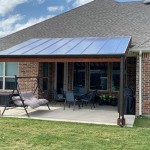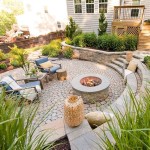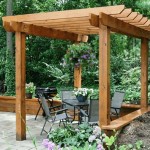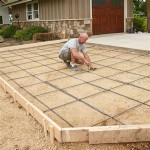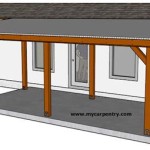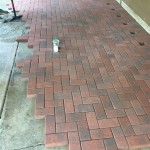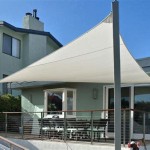Achieving Maximum Privacy With Outdoor Screens For Patios And Decks
Outdoor living spaces, such as patios and decks, offer an extension of the home, providing a peaceful retreat for relaxation, entertaining, and enjoying the fresh air. However, these spaces can sometimes lack the desired level of privacy, especially when surrounded by neighbors or busy streets. Outdoor screens offer a versatile and aesthetically pleasing solution to enhance privacy and create a more intimate atmosphere in these outdoor havens.
Outdoor screens are available in a wide range of materials, styles, and designs, allowing homeowners to seamlessly integrate them with their existing patio or deck aesthetic. From traditional wooden lattice screens to modern metal panels and even living green walls, the options are diverse and cater to various architectural preferences. The choice of material depends on factors such as budget, desired level of privacy, and the overall design theme.
Enhance Privacy and Create a Sense of Enclosure
The primary function of outdoor screens is to provide a physical barrier that obscures views from neighboring properties or the street. This creates a sense of enclosure and privacy, allowing homeowners to enjoy their outdoor space without feeling exposed. Screens can be strategically placed to block unwanted views, such as those from neighboring windows, busy sidewalks, or parking areas. The height and density of the screen material can be adjusted to achieve the desired level of privacy. For example, a solid screen made of wood or metal will offer complete privacy, while a screen with latticework or woven materials will allow for some airflow and filtered light.
Improve Aesthetics and Add Visual Interest
Beyond their practical benefits, outdoor screens can enhance the aesthetics of patios and decks, adding visual interest and complementing the overall design theme. Screens can be used to create distinct zones within the outdoor space, separating the dining area from the lounging area or defining a specific focal point. The design and materials of the screen can be chosen to match the existing architectural style of the home or to create a contrasting element that adds a touch of sophistication. For example, a modern home might benefit from sleek metal panels, while a traditional farmhouse could incorporate rustic wood lattice screens.
Protect From Elements and Offer Functionality
Outdoor screens can also serve practical purposes beyond privacy. They can provide protection from the elements, such as wind, sun, or rain. By creating a barrier, screens can reduce the impact of strong winds, create shade from harsh sunlight, and deflect rain, making the outdoor space more comfortable and usable year-round. Some screens are even designed to incorporate features like built-in planters, lighting fixtures, or storage compartments, adding additional functionality to the outdoor space.
Types of Outdoor Screens
The type of outdoor screen chosen should be carefully considered based on factors such as the desired level of privacy, aesthetics, budget, and the overall design theme of the patio or deck. Common types of outdoor screens include:
Wood Lattice Screens
Wood lattice screens are a classic and versatile option that offers a balance of privacy and visual interest. The latticework allows for some airflow and filtered light while providing a visual barrier. Wood lattice screens are easy to customize and can be stained or painted to match the existing décor. They are also relatively affordable and can be installed by homeowners with basic DIY skills.
Metal Panels
Metal panels offer a modern and sleek look, often made from aluminum or steel. They are strong and durable, resistant to rust and weathering, and provide complete privacy. Metal panels can be powder-coated in a variety of colors to complement the existing design scheme. Their sleek lines and contemporary aesthetic lend themselves well to modern and minimalist patios and decks.
Living Green Walls
Living green walls, also known as vertical gardens, create a stunning and eco-friendly privacy screen. These walls are comprised of planted vegetation, such as vines, ferns, or grasses, that grow up a supporting structure. Living green walls provide visual interest, privacy, and air purification benefits. They can be quite costly to install and require ongoing maintenance, but they offer a unique and environmentally friendly solution.
Fabric Screens
Fabric screens are a lightweight and flexible option, often made from canvas, mesh, or vinyl. They are easy to install and can be easily moved or adjusted as needed. Fabric screens offer some privacy but allow for more airflow and filtered light than solid screens. They are a good choice for temporary privacy solutions or for creating a more relaxed and airy atmosphere.
By carefully selecting the appropriate type of outdoor screen, homeowners can create a private and inviting outdoor space that enhances their enjoyment of their home. The range of options available ensures that there is a solution to suit every style and budget, allowing for the realization of a truly personal and peaceful sanctuary.

Screens The Most Cost Effective Way To Gain Privacy Conceal Eyesores Seattle Times

21 Deck Privacy Ideas For An Intimate Outdoor Oasis In 2024

18 Deck Privacy Ideas For Quiet Comfort Timbertech

Use A Privacy Fence For More Private Deck Or Patio

How To Add A Retractable Privacy Screen Your Outdoor Space

Outdoor Privacy Screens At Com

Screens The Most Cost Effective Way To Gain Privacy Conceal Eyesores Seattle Times

4 Privacy Screen Ideas For Backyards Of Any Size

18 Deck Privacy Ideas For Quiet Comfort Timbertech

4 Privacy Screen Ideas For Backyards Of Any Size
Related Posts

